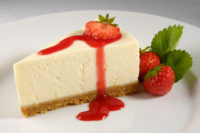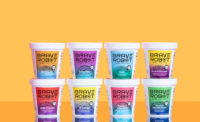It’s Halo Top’s world; we just live in it.
At least that’s the impression you’d get after either 1) talking to industry experts about the state of the frozen dairy dessert space or 2) actually surveying that space in your local supermarket.
Over the past few years, freezer cases have been filling up with a new class of creamy, dreamy treats that bear all the hallmarks of sinful indulgence while delivering more pluses (think protein and fiber) and fewer minuses (added sugar or “artificial” anything), to boot.
And as far as Thom King, president and CEO of Portland, Ore.-based Icon Foods, is concerned, it’s all thanks to Halo Top.
“I would say that it’s spreading like wildfire,” King said of the clean-indulgence trend that the Los Angeles-based ice cream brand almost singlehandedly spawned. “Every dairy processor that makes desserts has to be looking at this category,” he added.
As they do, they should ask themselves what “clean indulgence” means to today’s frozen dairy fans, and which ingredients help deliver it.
Drive for decadence
Americans have always been of two minds — or more — when balancing their attempts at good-for-you eating with their perpetual hunger for indulgence. But by broadening the definition of “good-for-you,” they’ve made it easier to hold all these concepts in their heads — and in their stomachs — at once.
“Currently, consumers have their own definitions of ‘clean’ and ‘indulgent,’” said Laura Bergan, director of innovation and market development, Barry Callebaut U.S.A., Chicago. “Many prefer products that have shorter ingredient lists, more common ingredients that they recognize and understand, and natural flavors, sweeteners and overall elements.
“Others gravitate to social or sourcing claims such as functional ingredients or organic labeling,” she added. “Premium or indulgent also can be subjective, with some consumers looking to origin chocolates, high cacao content, organics or similar qualities to drive a multisensorial experience.”
And their hunt for products that satisfy these needs increasingly takes them to the frozen dessert aisle, where despite the fact that “taste still tops most other factors, brands can give decadent desserts a health halo — and stay competitive — by incorporating clean ingredients,” said Jamie Wilson, director of business development, marketing, culinary, research & development for Parker Products, Fort Worth, Texas.
The original clean-ingredient treat
Some of the brands that Wilson’s already noticed embracing the “clean indulgence” trend include Yasso Frozen Greek Yogurt, Julie’s Organic frozen novelty desserts and, of course, Halo Top.
And when you consider — as Wilson and others do — that ice cream “is one of the original clean-ingredient foods,” their embrace of clean indulgence should come as no surprise.
“Ice cream is made from simple cream, milk, sugar and eggs,” Wilson pointed out. “By incorporating specialty ingredients that are similarly clean, brands can add even more decadence and intrigue to frozen desserts.”
Why go “dirty”?
But until recently, brands more often added some of the very ingredients that consumers now denounce as “unclean” — and for reasons that should also come as no surprise.
“Frozen desserts are among the most complex food systems we’ve created,” explained Brian Surratt, senior dairy applications scientist for Cargill, Wayzata, Minn. “They contain all three phases — solid, liquid and gas — and that makes it extremely challenging to manipulate critical ingredients. To be successful, you need a deep understanding of how each component interacts with the water, fat and air inherent to the system.”
And you need technically proficient functional adjuncts to keep those interactions in check.
“Consumers want a consistent product with a long shelf life,” said Jennifer Chaffin, application technologist, sweet flavors for Sensient Flavors, Hoffman Estates, Ill. “And some of the unfavorable ingredients we use today such as high-fructose corn syrup, preservatives and some stabilizers were industry-changing scientific breakthroughs that allowed us to increase food safety and shelf life. They’ve given us opportunities to innovate.”
They’ve eased production and improved performance, too, added Martin Ruiz, research chef at Parker Products. Industrial ingredients “didn’t require extra process steps, were less expensive and, unlike fruits that are periodically out of season, were always readily available,” he said. “Before the shift to clean labels and natural ingredients became the norm, artificial ingredients dominated the market, and it was simply less complicated and more cost-efficient to use them.”
That explains why the 20th century saw the dawn of untold variety — not just in frozen desserts, but also throughout the food system — at shockingly low prices. But variety and price alone no longer cut it.
“When consumers think ‘unclean,’ they think ‘cheap,’” said Ben George, R&D senior food scientist for Kerry, Beloit, Wis. “There was a time when consumers wanted the cheapest product available. Now times have changed, and people are reading ingredient labels and nutrition information and are generally more conscious of what they’re consuming.”
Back to basics
John Pimpo, sales manager at the Gertrude Hawk Ingredients division of Barry Callebaut U.S.A., Dunmore, Pa., acknowledges that consumers want indulgence when it comes to their desserts.
“However, there is a segment of consumers [who are] very label-conscious and will investigate labels to determine their treat choice,” he said. “It’s up to the food marketer or technologist to design that product to meet this consumer’s needs in taste and label. And in most cases, we can.”
Suppliers have answered the clean-formulating trend with clean ingredients that, almost paradoxically, outperform a number of “unclean” options, Ruiz noted.
“Additionally, consumers are now willing to pay more for clean-label products, which helps support continuous innovation and the feasibility of incorporating these new ingredients into formulations,” he said.
The trick is to find clean inputs that can multitask — keeping ingredient statements brief — and to explain what they’re doing in the mix.
“Consumers continue to seek personal connections to their food,” said Donna Klockeman, senior principal food scientist for TIC Gums, White Marsh, Md. “When food manufacturers take the time to explain why ingredients are used and where the come from, they’re able to build a relationship with the consumer and create a premium eating experience.”
Flavor from the source
Such relationships are becoming more important up and down the supply chain.
“We see this in the many requests we get to use extracts that enable our customers to tell a story of where their ingredients have been sourced, while at the same time checking all the other boxes of clean-label requirements,” Chaffin said.
Extracts’ growing popularity points beyond their mere “natural” positioning to something even more transparent and cleaner, she added.
“While consumers feel better about natural than artificial flavor, they feel best about natural extracts,” Chaffin said.
Better yet, George added, extracts, oils and essences improve a finished dessert’s flavor.
“A lemon oil coming directly from the fruit’s going to taste much more like real lemon than something made from chemicals in a lab,” he said. “Formulating frozen dessert mixes really does come down to a ‘less is more’ approach. Consumers are asking for frozen dessert companies to get back to their roots.”
Sophisticated simplicity
Just don’t sacrifice indulgence in the process. And Wilson believes there’s no need to.
“Consumers want to treat themselves with decadent desserts, and they shouldn’t have to let concerns about what’s in their food stop them,” she said. “It’s entirely possible to enjoy a butter pecan ice cream with fresh strawberries, toffee bites and shortbread pieces that’s non-GMO, all natural and all delicious.”
Emphasizing the “artisanal” or “craft” qualities of a frozen dessert and its ingredients also lets brands “elevate products to a higher realm — that ‘to which attention has been paid,’” said Thomas Payne, industry specialist for the U.S. Highbush Blueberry Council, San Mateo, Calif. “As such, they lend a kind of inherent virtue that connotes cleanliness, indulgence and premium all at once, and that conveys the sense that whatever the cost, they’re worth it. Even more important, you’re worth it.”
Bergan suggested using non-uniform inclusions for an added hand-crafted effect.
“These unique inclusions imply decadence and lend a premium artisanal look,” she said.
Keep it real
Bergan noted that real chocolate — as opposed to chocolate-flavored compound coatings that incorporate fats other than milkfat and pure cocoa butter — is now getting more airtime in frozen dairy desserts.
“Within frozen desserts and ice cream, real chocolate can be tricky from a production and consumer point of view,” she explained. “After chocolate is frozen in a frozen dessert, it takes considerable time for it to begin to soften to a point at which it can be consumed without jeopardizing the consumer experience.”
Bergan’s seen several brands use pure chocolate as coatings on ice cream bars or as inclusions, ribbons or layers in an ice cream pint.
“The marketing organizations within these companies have a great advantage in calling out ‘real chocolate’ on their labels and playing up both the premium/indulgent feature along with the clean feature,” she said.
They might even play up chocolate’s good-for-you features, as “cocoa and chocolate are being appreciated for more than just their indulgence factor,” said Gretchen Hadden, marketing communications manager for Cargill Cocoa & Chocolate North America.
Consumers now view cacao, the source of cocoa and chocolate, as a “superfood,” she said, and dark chocolate, being lower in sugar and higher in antioxidants than milk chocolate, “also has an increasingly authentic place in the indulgent, clean-label space. While cocoa and chocolate will always be appreciated first and foremost for the sensory experience they deliver, they certainly have a role in the clean-indulgence space.”
Payne believes that real blueberries have a role in the clean-indulgence space, too. He said they give frozen dessert formulators an all-in-one tool for delivering natural color, flavor, texture and nutrition.
“Frozen and IQF blueberries can be ground directly into frozen-dessert mixes, imparting a rich blueberry flavor and showing lots of blueberry in the skin,” he said. “Blueberry purée is wonderful in ice cream and sorbet and makes everything from patterns and squiggles to blueberry-pie ice cream and ice cream sandwiches with chunks of blueberries possible. And liquid blueberry coproducts have many applications, including smoothies, frozen desserts, ice creams and yogurts.”
It’ll cost you
If it all sounds too good to be true, it’s not. But formulating for clean indulgence will cost you. This isn’t necessarily a bad thing, Payne suggested.
While real blueberry ingredients might cost more, “this can actually add to their allure as premium in frozen dessert formulations,” he said. “After all, research shows that consumers are willing to pay extra for blueberry-containing products—a value-added plus both for product developers and consumers.”
King agreed.
“Our clean sweeteners aren’t cheap,” he said. “Sugar comes from subsidized crops, so it’s hard for us to compete pricewise. The downside is that using our sweetening systems usually drives up the costs of goods sold. But the upside is that consumers are willing to pay a little extra for a product that’s indulgent yet low in added sugars.”
For his part, Pimpo sees clean indulgence as a give and take.
“Frozen dairy desserts can absolutely be clean,” he insisted. “It just requires additional time and effort to source the proper ingredients to meet our customers’ needs. No matter what, indulgence continues to win over time. We strive for indulgence and — when we can — healthy indulgence.”





